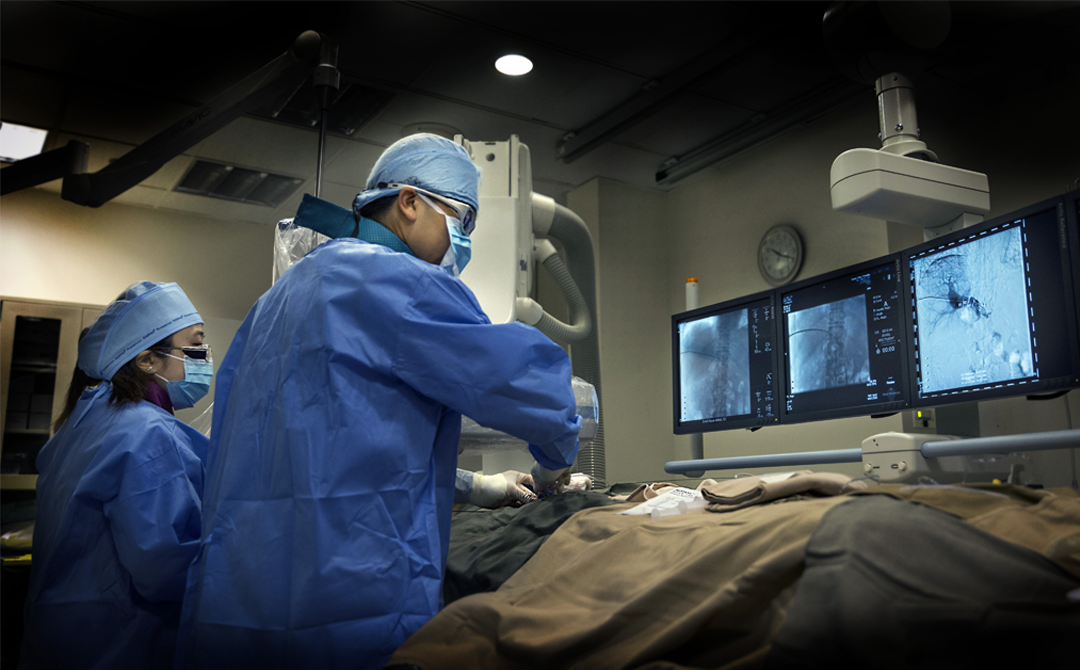

What Are X-Rays ?
X-rays are a type of electromagnetic waves. Its wavelength is extremely short, ususally expressed in nanometers. It cannot be visualised by human eyes. X-rays are produced after the bombardment of matter with high velocity electrons.
Medical Applications Of X-Rays
Since the discovery of X-rays in 1895, it has been widely used in the medical field as a diagnostic tool. For X-ray beams of the same energy, their penetration power varies with the density of matter. Images are produced when X-rays pass through organs with different densities. These images are particularly useful in diagnosis of various diseases eg. fracture and lung pathology. Recently, interventional radiological examinations with therapeutic applications have become more popular as an alternative to major operations.
Local Radiation Protection Rules
A set of Local Radiation Protection Rules is produced for the protection of staff, patients and members of the public in the Department of Radiology, Queen Mary Hospital. It is a simplified and tailored version of the "Code of Practice on Radiation Safety & Protection in HA Hospitals " and includes information and explanations on recommended procedures and possible risks pertaining to the safe use of radiation in the Department. (Please click here for the full document)
Local Radiation Protection Rules (NM)
A set of Local Radiation Protection Rules is produced for the protection of staff, patients and members of the public in Nuclear Medicine Unit, Queen Mary Hospital. (Please click here for the related document of Nuclear Medicine Unit, Queen Mary Hospital)
General Preparation
Objects that are dense enough to be imaged on film (like bra, necklace, belt, buttons or zippers) shoud be removed prior to the examination as they may result in diagnostic confusion. Suitable clothing will be provided by the department for radiologic examinations. There are examinations that do not require the change of clothing, such as hand and skull examinations. However, objects such as hairpins, earrings, rings and watches should be removed as they may be obscured the structures being investigated. Patients are advised to follow instructions given by our staff so as to minimize the chance of a repeat examination and hence additional radiation exposure.
Preparation For Special Examinations
In order to obtain optimal results, certain exams require special prepation. For example, gastrointestinal exams like small bowel enema and barium enema require bowel preparation with laxatives and cleansing enema. Fasting prior to the exam is done to ensure that the bowel lumen is free of residues. Some examinations require the injection of contrast agents into the veins eg intravenous urography. In a minority of patients allergic reaction, especially for patients with a known history of allergy or asthma, may occur. Such patients require prior ingestion or injection of medication that will reduce the chance of developing allergic reaction.
Effect Of X-Rays To The Human Body
Despite the benefits, excessive X-rays may cause harm to the human body. The children of pregnant patients may suffer from congenital abnormalities as a result of irradiation. X-rays may also cause abnormal cellular proliferation resulting in cancer development. In addition, lead shields and lead aprons are usedwhenever appropriate in order to reduce radation to the parts outside the areas of interest..
28-Day Rule, 10-Day Rule
X-rays are detrimental to the developing foetus. Every woman of child-bearing age presenting for a radiological examination that involves direct abdominal or pelvic irradiation would be asked whether she is or might be pregnant. If the possibility of pregnancy is excluded, we would proceed with the radiological examination. If the possibility of pregnancy cannot be excluded, she would be asked whether her last menstrual period is overdue. If it is overdue, i.e. outside the past 28 days, consideration would be given to postpone the examination - the "28-day rule". For high radiation dose procedures such as abdominal or pelvic computer tomography and barium enema, the examination may be postponed to the early part (first 10 days) of the menstrual cycle - "10-day rule". Exception would include urgent radiological examinations when benefits of the examination are likely to far outweigh any small risk to the foetus from irradiation.